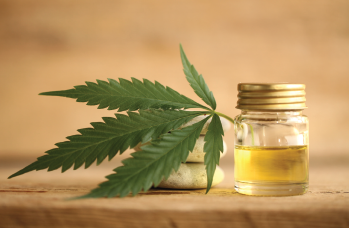 Andrew Winkler, MD, associate professor of otolaryngology and director of facial plastic and reconstructive surgery at the University of Colorado, Denver, works in one of the first two states to legalize recreational marijuana and has done research to investigate links between marijuana legalization and facial trauma. But, when patients ask him questions about medical marijuana use, including the ubiquitous cannabidiol (CBD) oil, he often feels ill-equipped to respond.
Andrew Winkler, MD, associate professor of otolaryngology and director of facial plastic and reconstructive surgery at the University of Colorado, Denver, works in one of the first two states to legalize recreational marijuana and has done research to investigate links between marijuana legalization and facial trauma. But, when patients ask him questions about medical marijuana use, including the ubiquitous cannabidiol (CBD) oil, he often feels ill-equipped to respond.
Explore This Issue
September 2019“It’s a tricky thing,” he said. “It’s a difficult position. We get asked by our patients—not a lot, but on occasion—about using these medications to treat pain and just recreationally around times of surgery. And I don’t feel like I have a great answer for them a lot of times.”
He said that he recommends patients not smoke marijuana near the time of surgery. “My usual response is, ‘We don’t like smoke in or around surgery, so if you can switch over to oral forms, then I’m OK with it,’” he said. “What is the effect of that on wound healing or pain? I really don’t know.”
States are legalizing marijuana products for medical purposes and recreation at a fast rate—it’s legal at least for medical reasons in 33 states—and CBD shops are popping up everywhere, with CBD gummies, CBD chocolates, CBD caramels, and CBD cupcakes, as well as CBD lotions, balms, and salves. These, along with CBD and cannabis vaping pens and thumb drives, let people customize their CBD experiences.
All of this is tantalizing to customers and patients. But as patients become more interested in cannabis for their conditions, physicians, including otolaryngologists, are still awash in uncertainty and trepidation when it comes to whether and how to use marijuana products in their care plans. The interest level among otolaryngologists in medical marijuana products seems to be growing, and the push continues for more research, as well as the release of federal dollars and approval of policies to make this research more feasible.
Limited Data
Although he is in the state that could be considered the cannabis capital of the U.S., Dr. Winkler said he has never recommended any form of marijuana to patients, including CBD oil, as a medical therapy. His knowledge is unavoidably limited to the scant research and to the word of mouth of colleagues, he said. An anesthesiologist colleague who ran a pain clinic has told him that “he wasn’t super convinced that it had a huge effect in his practice.” It’s these types of observations and feedback on which Dr. Winkler largely relies.
“He said, in his opinion, the data on chronic pain was limited, and certainly in acute pain,” Dr. Winkler said. “But, of course, there are different formulations, and that was a while ago. So I’d be interested in using it—I’m not against using it—it’s just I would like to see more data.”
Dr. Winkler has done his own research, looking at incidence of facial trauma in Colorado in the two years before legalization of recreational marijuana compared with the two years after. He hypothesized that facial trauma incidence could go up if people behaved irresponsibly as a result of marijuana use, or perhaps go down if it had a calming effect and led to fewer assaults. Ultimately, there was no difference, although he acknowledged that two years is a relatively short time and behavioral patterns following legalization are undoubtedly continuing to be re-shaped.
Responding to the explosion of interest in cannabidiol—one of the more than 100 compounds, or cannabinoids, that are unique to the cannabis plant—and other marijuana products, the Food and Drug Administration (FDA) recently released a consumer update. It contained little medical guidance. “Other than one prescription drug product to treat rare, severe forms of epilepsy, the FDA has not approved any other CBD products, and there is very limited available information about CBD, including about its effects on the body,” the update said. It also said the FDA is looking into safety questions, including potential liver toxicity and cumulative exposure if CBD is used in a variety of forms at the same time, such as in the case of someone who eats CBD gummies, rubs CBD lotion on their skin, and vapes every night.
In what might be the most authoritative review undertaken on the limited research that has been conducted on medical marijuana products, including CBD oil and other forms, an expert committee of the National Academies of Science, Engineering, and Medicine determined that oral cannabinoids are “effective antiemetics” for adults with chemotherapy-induced nausea and vomiting. The group also determined that adults with chronic pain who were treated with cannabis or cannabinoids were more likely to experience clinically significant reduction in pain symptoms, and that using oral cannabinoids improves patient-reported spasticity symptoms in adults with multiple sclerosis.
“For these conditions, the effects of cannabinoids are modest,” the committee wrote. “For all other conditions evaluated, there is inadequate information to assess their effects.”
Among the report’s most prominent findings on the potentially negative effects of cannabis and cannabinoids, the committee found there is strong evidence of a statistical link between long-term cannabis smoking and worse respiratory symptoms and more frequent bronchitis episodes. But the group also found some evidence of no statistical link between cannabis smoking and the incidence of lung cancer.